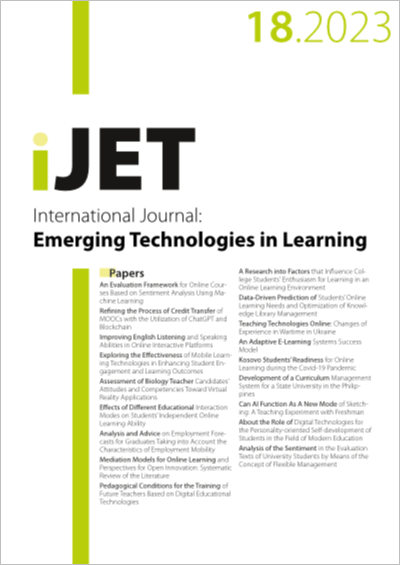Effects of Different Educational Interaction Modes on Students’ Independent Online Learning Ability
DOI:
https://doi.org/10.3991/ijet.v18i18.42531Keywords:
classroom teaching interaction, online learning, independent learning ability, questionnaire survey, analysis of varianceAbstract
The high-speed applications of information technologies such as artificial intelligence (AI), cloud computing, and 5G promote the development of different industries and also have extensive effects on online education. Online teaching can offset normal and traditional education shortages in learning time and places and meet learners’ demand for fragmented learning in the Internet era. An effective educational interaction mode can stimulate the learning interest of students, promote the occurrence of deep learning of students, and facilitate the development of their online independent learning ability. In this study, the effects of educational interaction modes (including teacher-teacher interaction, teacher-student interaction, student-student interaction, and learner-interface interaction) on the online independent learning ability of learners were analyzed based on cooperative learning theory and personalized learning theory. Differences in online independent learning ability under different contact duration with online learning were measured. Results demonstrate that the reliability coefficient and KMO value of the questionnaire are 0.889 and 0.863, indicating that the questionnaire has good reliability and validity. The teacher-teacher interaction, teacher-student interaction, student-student interaction, and learner-interface interaction of educational interaction modes can promote the improvement of online independent learning ability of learners significantly under 1%, 1%, 5%, and 1% levels, respectively. Contact duration with online learning significantly affects online independent learning ability at the 0.05 level (F = 2.487, p = 0.031). Research conclusions can provide important references to perfect the high-efficiency implementation strategy of educational interaction modes in the online classroom environment and find keyways to improve the effect and quality of synchronous classroom teaching interaction.
Downloads
Published
How to Cite
Issue
Section
License
Copyright (c) 2023 Peng Wang

This work is licensed under a Creative Commons Attribution 4.0 International License.



